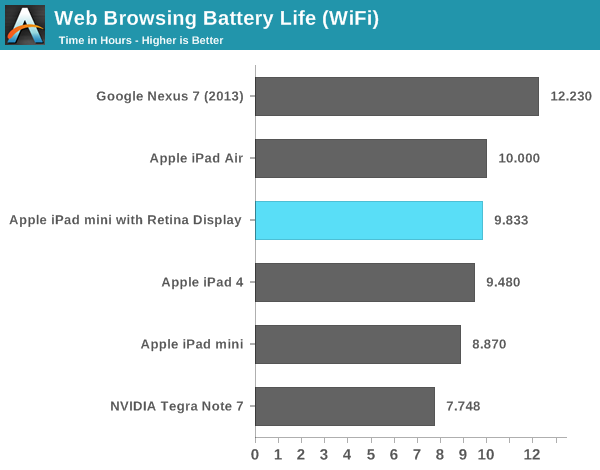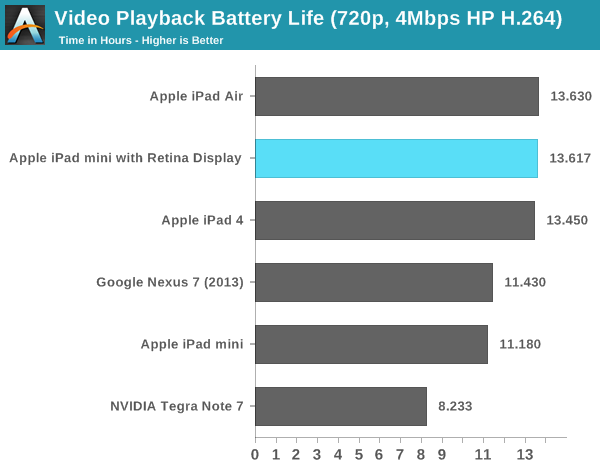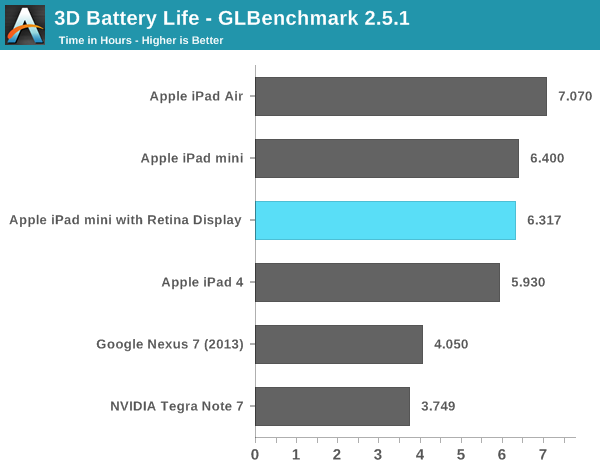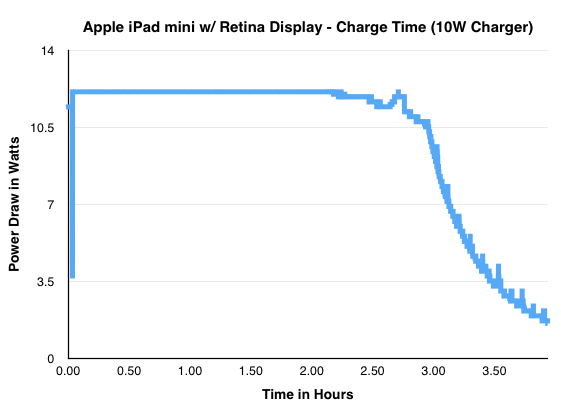Apple iPad mini with Retina Display: Reviewed
by Anand Lal Shimpi on November 16, 2013 8:00 AM ESTBattery Life
Thanks to the mini’s integrated 23.8Wh battery (and the low idle power of the 28nm A7), the Retina Display’s power consumption is more than offset. Battery life in all of our tests is at worst unchanged from the mini, but at best we’re talking about a 21% increase.
Our web browsing test shows a 10% improvement compared to the original iPad mini. The new mini with Retina Display can even last longer than a 4th generation iPad, and it’s hot on the heels of the iPad Air (I'll be updating this section with LTE and LTE hotspot results).

Video playback is where we see the biggest improvement compared to the original mini. Here the new iPad mini lasts 21% longer on a single charge, once again outlasting even the iPad 4. The iPad Air doesn’t offer any appreciable gain in battery life over the Retina mini.

Our 3D battery life test is the only one where the old mini manages to beat the new Retina model. With a 1.31% margin of victory though, it’s pretty safe to say that for current 3D gaming workloads you’ll see similar battery life out of the Retina mini as the old model. This is also the only test where the iPad Air delivers better battery life on a single charge (~11%).

Apple ships the Retina mini with a 10W USB charger and lightning cable. This appears to be the same charger as what shipped with the 3rd generation iPad (but obviously with a different cable). Using the newer 12W charger from the iPad 4/Air has no impact on charge time as the mini still only draws a maximum of 11.7W at the wall (compared to 13.8W for the iPad Air).

The iPad mini with Retina Display completes a charge from 0 to 100% in a sliver under 4 hours. That’s a little quicker than the iPad Air, and similar to the original mini with its 5W charger.











345 Comments
View All Comments
michal1980 - Saturday, November 16, 2013 - link
you must not have been here long enough. I'm still waiting for anand to change his name to appletigmd99 - Saturday, November 16, 2013 - link
Prove his bias.tigmd99 - Saturday, November 16, 2013 - link
What has he said about either OS that is not true?Puberticus - Saturday, November 16, 2013 - link
Seriously: if you don't like Apple gear and you weren't interested in a detailed review, why are you even commenting?pgari - Saturday, November 16, 2013 - link
I found Anand reviews a lot more unbiased (if any) than most of the people criticizing him: as a minimum he recognizes the weakness on Apple products as well the competitors' strengths, no as some people here who demonize Apple and reject all its products blindly.Disclaimer: My smartphone is a Nexus 5, my tablet a Venue 8 Pro and my laptop a MBA
tipoo - Saturday, November 16, 2013 - link
Shame about the inferior display gamut and slower soc. Makes the choice between it and Air a bit muddier. Funny how when the first display comparisons went around the apple faithful thought it was a hoax, lol.solipsism - Saturday, November 16, 2013 - link
For me it's not a deal breaker as I never use my iPad much. It's mostly for reading so I'm hoping the iPad Mini will be a better fit than the 10" variant.Overall that display is very impressive, but those displays on Amazon Kindle HGX and Nexus 7 are even more impressive when you consider their cost. Sure, they aren't profiting and use them to sell there other services unlike Apple who's model is to sell HW, but's still impressive. The only reason I haven't chosen them since I can read just fine on them is the awful 16:10 and 16:9, respectively, aspect ratio. 4:3 is considerably more ideal and I wish others would follow.
teiglin - Saturday, November 16, 2013 - link
Both of the Kindle Fire HDXs and the Nexus 7 are 16:10 (1920x1200 on the 7"-ers, and 2560x1600 on the HDX 8.9). Also the phrase "considerably more ideal" makes my brain hurt. As Brian once said, the battle for 4:3 is over and lost outside the iPad space (and LG phablets -_-)--even the iPhone gave up that ghost. I do miss 4:3 on the desktop though.solipsism - Saturday, November 16, 2013 - link
1) The iPhone was never 4:3.2) "More ideal" is not the same as "ideal".
3) There is obsolescing of aspect ratios as much you want to believe there is such a thing. There is only aspect ratios that are utilized for specific purposes and on a tablet 16:9 or 16:10 is not good for reading text, but 4:3 is. 16:9 is *more ideal* than 4:3 for video since it's closer to the common widescreen formats but most users don't spend the majority of their time watching videos.
teiglin - Sunday, November 17, 2013 - link
1) You're right, old iPhones were 3:2, but the point is that it gave up the fight against widescreen, just like other market segments.2) And I still take semantic issue with the idea of comparative ideal-ness--something is ideal, or it isn't. Something can be better or worse for a particular purpose, or closer to the ideal, but not more or less ideal.
3) Either you're missing a "no" in your first sentence, or I'm very confused. Either way, aside from my semantic quibbles, I don't generally disagree with what you're saying--4:3 is generally better for interacting with text than 16:9/10. Nevertheless, the fact remains that 16:9 is the standard for the vast majority of displays sold today, no matter how much I miss my first desktop LCD with its 5:4 aspect ratio.
What I find interesting in the discussion of aspect ratio is the lack of actual measurements. I mean, people mostly compare 7" tablets to the iPad mini, but the iPad mini's display is actually the same width as the 8.9" Kindle Fire's display (give or take a few hundredths of an inch). So maybe that should be the point of comparison for how much text you can display?